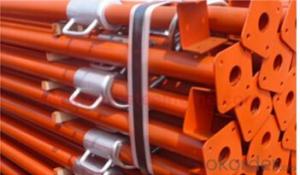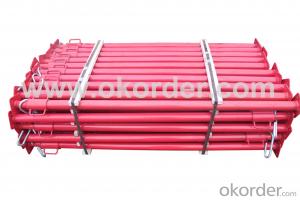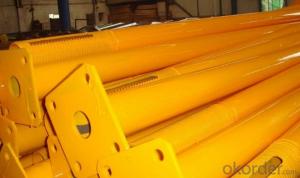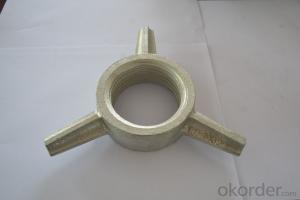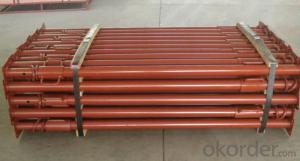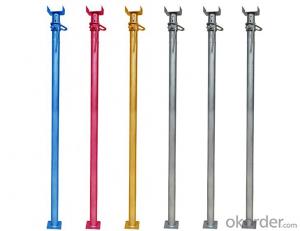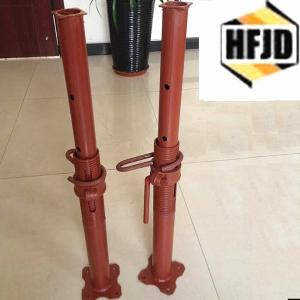Scaffolding Steel Props / Shoring Props for Scaffolding System
- Loading Port:
- China main port
- Payment Terms:
- TT OR LC
- Min Order Qty:
- 1000 pc
- Supply Capability:
- 1000000 pc/month
OKorder Service Pledge
OKorder Financial Service
You Might Also Like
Product information:
Model Number: GTJ-P003
Name: Q235 High Quality Steel Slab Props
Material: Q235
Thickness: 1.6mm to3mm or as your requirements
Surface Treatment: as per requirements
Standard: use your standard or international standard
Dimension: Light duty 40-48mm, MID Duty 48-56/58mm, Heavy duty 48-60mm
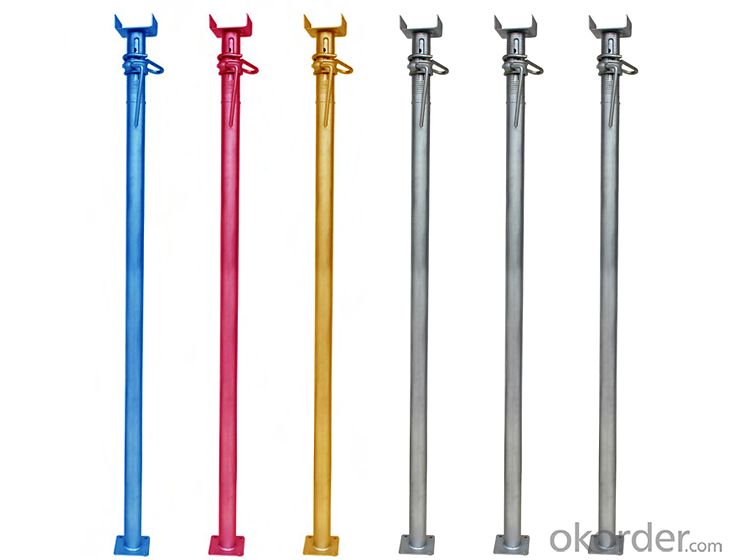
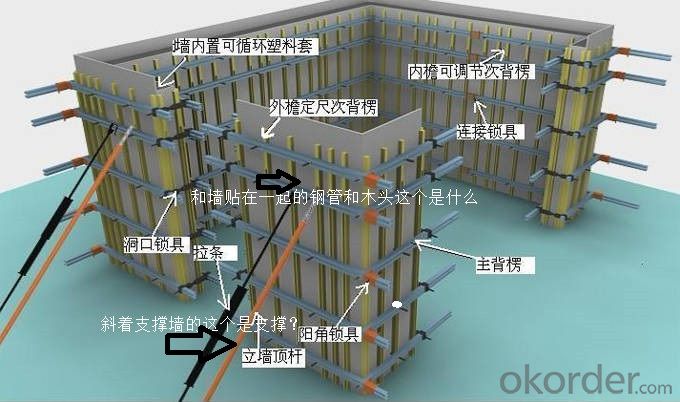
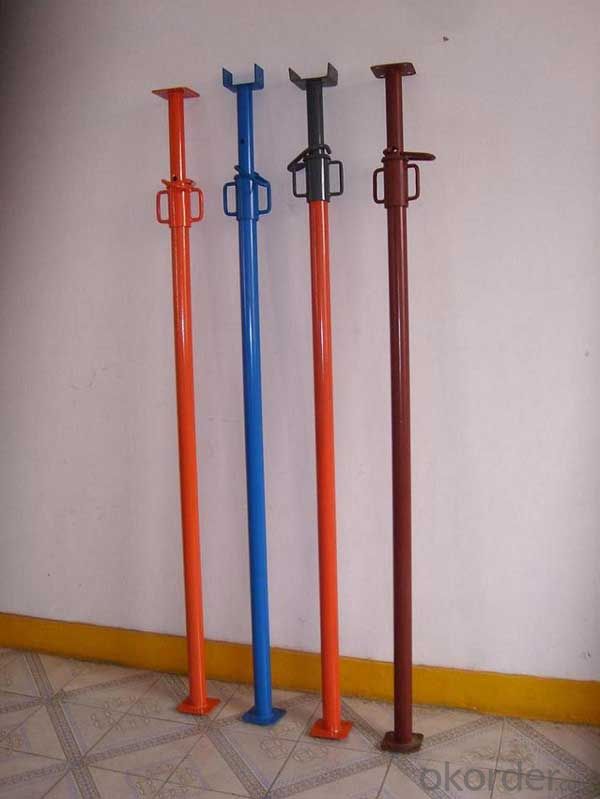
Characteristics:
1. Reliable performance
2. Corrosion resistance
3. Durable finish standards
Functions
It is used for construction supporting, timber, formwork, concrete slab and so on. It is very easy and reliable to use
Why Choose Us
1. We are experienced manufacturer in Hebei with more than 4 years experience and cooperating with more many countries.
2. We supply qualified products which are certified by SGS and ISO9001:2008. Strict QC to make sure your profit.
3. Timely delivery can be guaranteed because we have a factory which covers an area of 30000sqm and its daily output is more than 50 tons.
4. A competitive price can be offered because we are a professional manufacturer of scaffolding with an advantage on cost-controlling & production management.
- Q:Can steel props be used for temporary support during renovations?
- Certainly, temporary support during renovations can be achieved by using steel props. These props, also known as adjustable steel props or acrow props, are widely utilized in construction and renovation endeavors to offer temporary support to structures. Their adjustable height feature makes them adaptable and appropriate for various applications. When conducting renovations that involve the removal or modification of walls or other supporting structures, steel props can be employed to provide temporary support until the necessary work is finished. Typically, these props are positioned beneath beams, ceilings, or floors to prevent any potential collapse or structural damage. Steel props are renowned for their strength, stability, and capacity to bear heavy loads. They are engineered to withstand substantial weights and provide dependable support, ensuring the safety of workers and the structure itself during renovations. The adjustable nature of these props enables precise height adjustments, guaranteeing a proper fit and support for diverse construction and renovation requirements. In addition to their strength and adjustability, steel props are also effortless to install and remove. This convenience makes them an ideal choice for temporary support during renovations, as they can be swiftly set up and dismantled as required. Overall, steel props are a trustworthy and frequently employed solution for temporary support during renovations. They offer stability, load-bearing capacity, and versatility, making them suitable for a broad range of construction and renovation projects.
- Q:Are steel props adjustable with remote control mechanisms?
- No, steel props are not typically adjustable with remote control mechanisms. They are usually manually adjusted by hand or with the use of mechanical tools.
- Q:Can steel props be used in supporting precast concrete elements during installation?
- Steel props, also referred to as adjustable steel props or adjustable steel shores, can be utilized to provide support to precast concrete elements while they are being installed. In the realm of construction, steel props are commonly employed as a temporary support system for structures or elements. They are specifically beneficial in the context of precast concrete elements due to their durability, ability to be adjusted, and stability. When installing precast concrete elements, steel props are typically positioned beneath the elements to offer vertical support and prevent any sagging or collapse. The height of the props can be easily modified to accommodate different elevations or to ensure a level installation. This adjustability is particularly advantageous when dealing with uneven ground conditions or when aligning multiple precast elements. Steel props are engineered to endure substantial loads and provide a dependable support system for precast concrete elements. They are typically fabricated using high-quality steel with a robust construction, enabling them to bear the weight of the elements without any deformation or failure. In addition to their strength and adjustability, steel props provide stability throughout the installation process. They are equipped with base plates or feet that establish a solid foundation, ensuring that the props remain securely in place. This stability is crucial in preventing any unforeseen movement or shifting of the precast elements, which could potentially result in damage or safety hazards. All in all, steel props are a suitable choice for supporting precast concrete elements during installation. Their strength, adjustability, and stability make them a reliable and efficient solution for ensuring a successful and safe installation process.
- Q:Do you have a 400*16 model of steel support
- It is not a question of how the steel supports have the type of the 400*16, but what you need to do to support the design of the load, force, material, etc.. After the calculation, what need to support what support. 400*16 is also one of the options.
- Q:What are the standard sizes of steel props?
- The standard sizes of steel props can vary depending on the manufacturer and region, but common sizes range from 1.8 meters to 5 meters in length, with adjustable heights typically ranging from 1.1 meters to 4.8 meters.
- Q:Can steel props be used in the construction of temporary storage tanks or silos?
- Yes, steel props can be used in the construction of temporary storage tanks or silos. Steel props are commonly used to provide temporary support during construction projects, including the erection of tanks and silos. They can be easily adjusted to the required height and provide stability and load-bearing capacity. Additionally, steel props are resistant to corrosion and can withstand heavy loads, making them suitable for use in the construction of temporary storage tanks or silos.
- Q:How do you ensure proper leveling of steel props?
- To achieve proper leveling of steel props, several key steps need to be taken. First and foremost, it is imperative to assess the ground conditions where the props will be placed. The ground must be solid and even, devoid of loose soil or debris. If necessary, the ground can be made compact or level by employing a compactor or a leveling tool. Subsequently, a thorough inspection of the steel props themselves should be conducted to detect any damage or defects. It is crucial to utilize props that are in excellent condition and appropriate for the intended load. Furthermore, the props should be of the correct height for the specific application. When positioning the props, it is vital to utilize a spirit level to ensure their absolute verticality. This can be achieved by adjusting the prop's height using the prop adjustment mechanism. The spirit level should be placed on top of the prop and checked from all angles to ensure precision. Additionally, it is advisable to utilize a prop plate or a sturdy base beneath the prop to evenly distribute the load and prevent any sinking or tilting. The prop plate should be placed on a stable surface such as a concrete slab or a steel plate. Once the props are in place, periodic checking and adjustment should be carried out as necessary. This is particularly crucial if there are any alterations in the load or ground conditions that may affect the props' leveling. In conclusion, achieving proper leveling of steel props involves assessing the ground conditions, inspecting the props, utilizing a spirit level for vertical alignment, utilizing a prop plate for stability, and regularly monitoring and adjusting the props as needed. By adhering to these steps, a secure and stable support system can be established.
- Q:How are steel props adjusted for different heights?
- Steel props can be adjusted for different heights by using a threaded mechanism. The prop consists of an inner tube and an outer tube with multiple holes. By rotating the inner tube and aligning the desired hole with a pin, the prop can be set at the desired height. The pin locks the tubes together, ensuring stability and load-bearing capacity. This adjustable feature makes steel props versatile and suitable for various construction applications.
- Q:Can steel props be used in mining projects?
- Steel props are indeed applicable in mining projects. They go by the names of temporary supports or temporary roof supports, and their purpose is to offer temporary structural reinforcement to the roof and walls of mine tunnels or shafts. Constructed from durable, high-strength steel, these props are engineered to endure the immense weight and pressure exerted by the surrounding rock and soil. Their adjustable length feature facilitates effortless installation and removal throughout the course of mining operations. The indispensability of steel props lies in their ability to avert roof collapses and maintain the stability of underground workings, making them a crucial element in ensuring mine safety.
- Q:How do steel props compare to telescopic props?
- Construction projects commonly use steel props and telescopic props to support vertical loads, but they have distinct differences. Adjustable steel props, also called acrow props or adjustable steel props, are usually made of steel tubes and have a screw thread mechanism for height adjustment. Their strength and durability make them ideal for supporting heavy loads. They are commonly used for shoring, formwork, and supporting beams and columns during construction. They can be easily adjusted to the desired height and come in various sizes to accommodate different load requirements. On the other hand, telescopic props, also known as aluminum props, are made of lightweight aluminum tubes. They have a telescopic mechanism that allows for quick and easy height adjustment. Telescopic props are known for their portability and ease of handling. They are commonly used in lightweight construction projects, like residential buildings, where smaller loads need support. When comparing steel props to telescopic props, several factors should be considered: 1. Load capacity: Steel props are generally stronger and have a higher load capacity than telescopic props. They are designed to handle heavier loads and are more suitable for supporting large structures or heavy equipment. 2. Durability: Steel props are known for their robust construction and longevity, making them suitable for long-term use. Telescopic props, while still durable, may not withstand heavy loads or rough handling as well as steel props. 3. Adjustability: Both types of props offer adjustability, but the mechanisms differ. Steel props use a screw thread mechanism for precise height adjustment and secure locking. Telescopic props, on the other hand, have a telescopic mechanism that allows for quick and easy height adjustments, but they may not provide the same level of precision as steel props. 4. Portability: Telescopic props are lighter and more portable than steel props due to their aluminum construction. This makes them easier to transport and handle on construction sites, especially in projects that require frequent adjustments. In conclusion, steel props are generally preferred for heavy-duty applications and projects that require higher load capacities, durability, and precise adjustments. Telescopic props, on the other hand, are more suitable for lightweight construction projects that require portability and quick height adjustments. The choice between these two types of props ultimately depends on the specific requirements of the construction project at hand.
1. Manufacturer Overview |
|
|---|---|
| Location | |
| Year Established | |
| Annual Output Value | |
| Main Markets | |
| Company Certifications | |
2. Manufacturer Certificates |
|
|---|---|
| a) Certification Name | |
| Range | |
| Reference | |
| Validity Period | |
3. Manufacturer Capability |
|
|---|---|
| a)Trade Capacity | |
| Nearest Port | |
| Export Percentage | |
| No.of Employees in Trade Department | |
| Language Spoken: | |
| b)Factory Information | |
| Factory Size: | |
| No. of Production Lines | |
| Contract Manufacturing | |
| Product Price Range | |
Send your message to us
Scaffolding Steel Props / Shoring Props for Scaffolding System
- Loading Port:
- China main port
- Payment Terms:
- TT OR LC
- Min Order Qty:
- 1000 pc
- Supply Capability:
- 1000000 pc/month
OKorder Service Pledge
OKorder Financial Service
Similar products
New products
Hot products
Hot Searches
Related keywords
